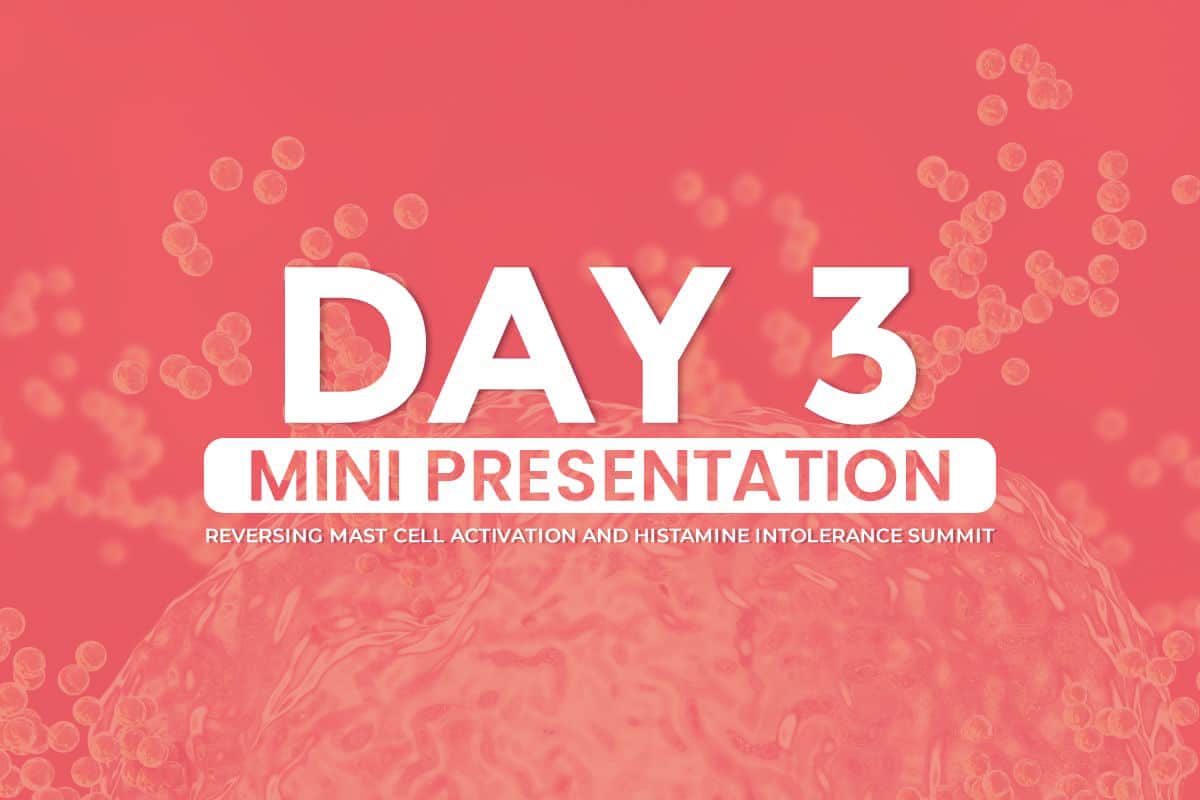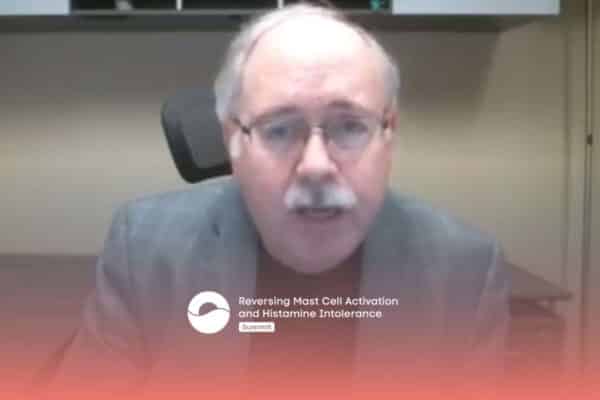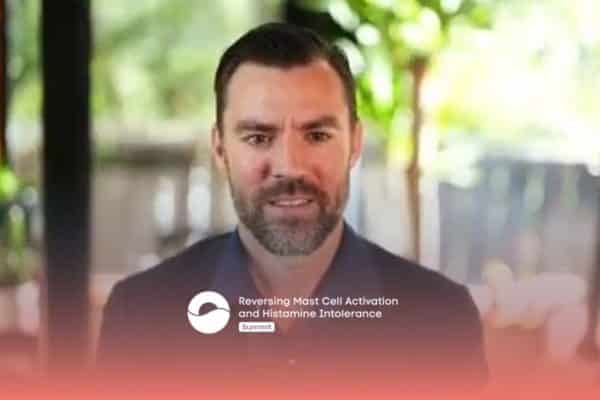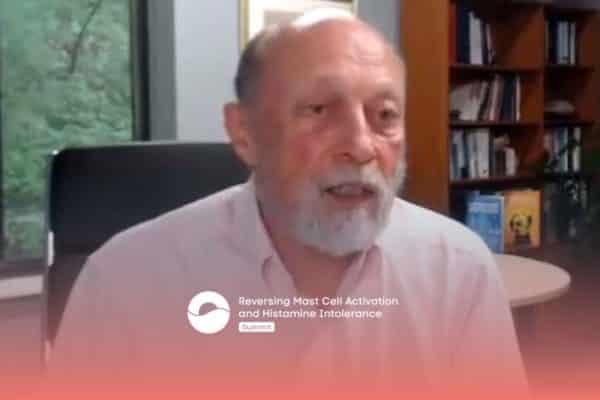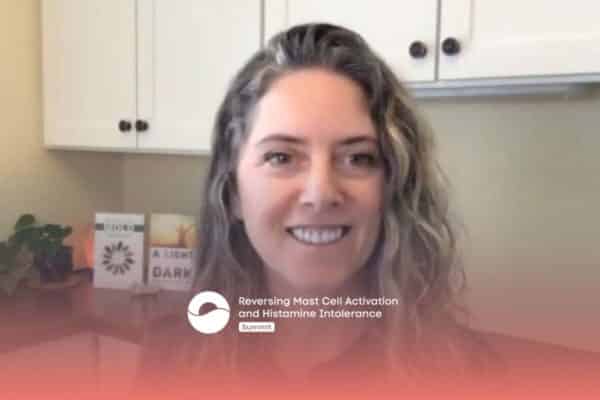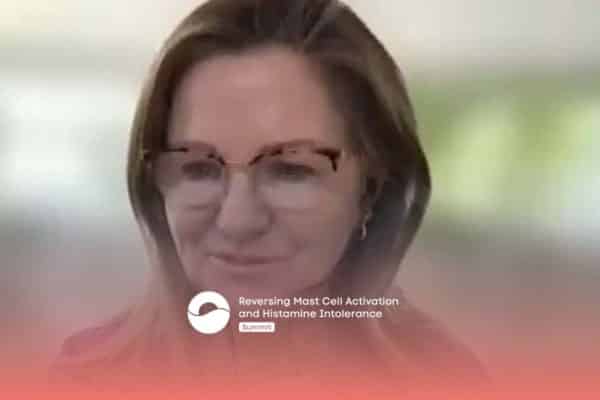Join the discussion below
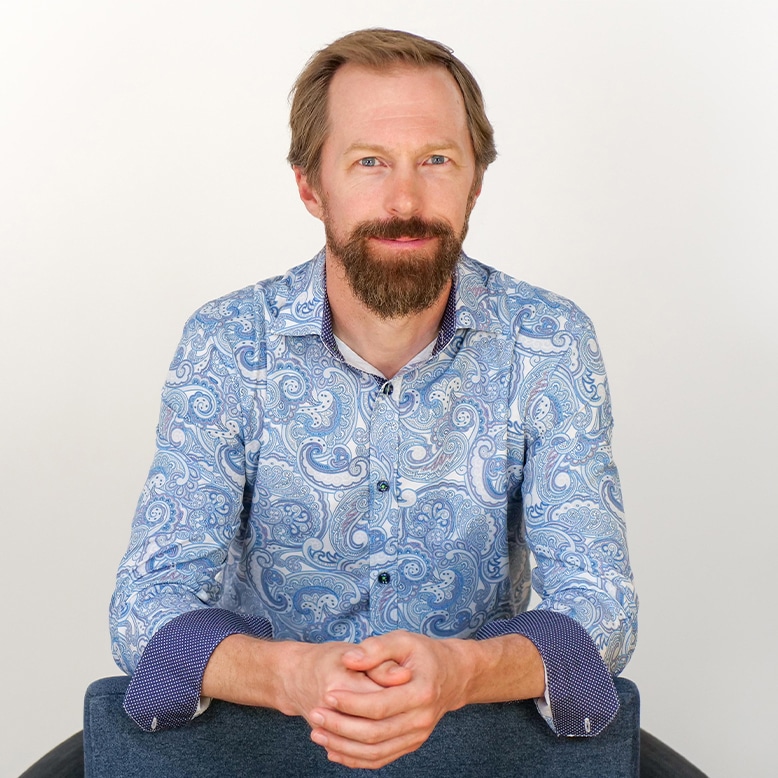
Dr. Tom treats some of the sickest, most sensitive patients suffering from chronic Lyme disease, tick-borne co-infections, mold illness as well as children with infection-induced autoimmune encephalitis (PANS/PANDAS). He focuses on optimizing the body’s self-healing systems in order to achieve optimal health with simple, natural interventions; utilizing more conventional approaches... Read More
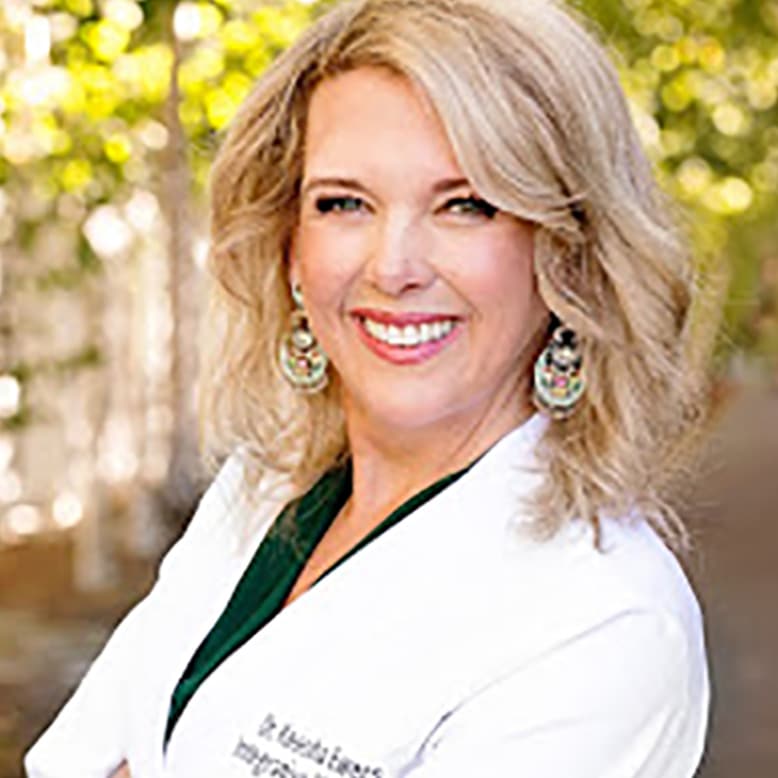
Keesha Ewers, PhD, ARNP-FNP-C, AAP, IFM-C
Dr. Keesha Ewers is an integrative medicine expert, Doctor of Sexology, Family Practice ARNP, Psychotherapist, herbalist, is board certified in functional medicine and Ayurvedic medicine, and is the founder and medical director of the Academy for Integrative Medicine Health Coach Certification Program. Dr. Keesha has been in the medical field... Read More
- The role of unresolved trauma in illness and healing
- What is the relationship between trauma, autoimmunity and MCAS?
- Perception creates reality (and illness)
Related Topics
Anger, Autoimmune Disease, Ayurvedic Medicine, Childhood Trauma, Conventional Medicine, Epigenetics, Genetics, Healing, Integrative Medicine, Leaky Gut, Mast Cell Activation, Meditation, Mental Health, Microbiome, Mindset, Psychotherapy, Rheumatoid Arthritis, Sexual Abuse, Toxic Burden, Trauma, YogaTom Moorcroft, DO
Hey everybody, Dr. Tom Moorcroft back here with you for the Reversing Mast Cell Activation Syndrome and Histamine Intolerance Summit. Thanks for joining us today. It’s gonna be an amazing episode. Today we have Dr. Keesha Ewers who’s an Integrative Medicine Expert, Doctor of Sexology, which is super rad, Family Practice, APRN, Psychotherapist, Herbalist, Board Certified and Functional Medicine, and Ayurvedic Medicine, and the Founder and Medical Director of the Academy of Integrative Medicine, Health Code Certification Program. And Dr. Keesha’s been in the medical field for over 30 years. And after conducting the HURT Study in 2013, which is Healing Unresolved Trauma, she developed the HURT model for understanding how past childhood trauma affects adult health. And I think that that’s gonna really dovetail into everything we’re talking about with mast cell activation in our summit. After the HURT study and the creation of that model, that led to the creation of the UN-Broken Online Program for patients to heal their own trauma and the Mystic Medicine Deep Immersion Healing Retreats that she leads at her home in San Juan Island, Washington.
And she’s a popular speaker on tons of stages, Harvard, TEDx, and all these other cool places. But one thing I wanted to share is I was like where you get to meet people. I remember deciding at one point in my life seeing one on one and just working in my office wasn’t enough to make the healing changes we needed to make in the globe and so I stepped out and the organization, when I first went out there, Keesha, you were one of the first people that I saw who is doing stuff that I didn’t even know was possible, and it just making such a massive impact, and you’ve always been an inspiration. And it’s nice that I finally get a chance to talk about what you’re doing. So thanks for joining us.
Keesha Ewers, PhD, ARNP-FNP-C, AAP, IFM-C
Thank you, that’s so sweet to know.
Tom Moorcroft, DO
It’s crazy, it’s like you are all in here. Like, I got in the medicine, I was like, “I feel like I have to do all this myself.” And I’m like, “Wait, other people think this way.” But we were still pigeonholed. And then to see people who are reaching so many people, so, I’ve always wondered. I mean, how did you come to this work and how’d you go from where you were to where you are now?
Keesha Ewers, PhD, ARNP-FNP-C, AAP, IFM-C
Yeah, we all have a story, don’t we, yeah. So for me, I started out as a young nurse at the age of 19 being an adrenaline junkie. I really liked the high intensive care unit life like. I was a marathon runner, I liked to skydive. I was just crazy that way. And then I got married and I started having children, I had four kids. And I drove myself in the same way in every role that I had. I didn’t compete against others, but I was always driving myself to bring my best self to every arena that I was in. And that’s really, now what I can identify is incredibly toxic perfectionism. And so in my early 30s, I was diagnosed with rheumatoid arthritis. And I woke up one day, and it was like all of a sudden how my patients describe it, “Well, we know that’s not true. You don’t all of a sudden get an autoimmune disease.” But all of a sudden I wake up and I’ve got 10 extra pounds of puffiness all over my joints, red, swollen, inflamed.
And it was like someone had taken the batteries out of the Energizer Bunny, I was just flattened. And I got myself into a doctor. And in the course of the history taking process, she asked me if I had a family history of autoimmune disease, then I said, “Yeah, I think my grandfather had RA.” and he actually died at the age I am right now I’m 57. And I never knew him. And I knew that he’d been wheelchair bound with it for a lot of years and was very sick. And she quickly wrote out prescription for methotrexate and another one for non-steroidal anti-inflammatory drug handed them to me and said, “When do you get worse, not if, come back and we’ll change your meds.” And I remember saying, “Well, hang on, hang on.” She’s on her way out the door. I’m like, wait. And I said, “I’m really disciplined. I run, I make my own food. What else is there?” And her response, which people, I’m 57 now, this is when I was in my early 30s. So 25, 26 years ago, people are still hearing this today.
Tom Moorcroft, DO
The same exact thing, right?
Keesha Ewers, PhD, ARNP-FNP-C, AAP, IFM-C
Same exact thing. Come back when you’re worse, we’ll change your class of meds. And no, nothing else has to do with this. It’s genetic, and therefore I close the book, put on the shelf. That’s all there is to say about the subject, right?
Tom Moorcroft, DO
Yeah.
Keesha Ewers, PhD, ARNP-FNP-C, AAP, IFM-C
And I remember on my way home thinking the model of medicine that I’ve been brought up and trained in and practiced for all these years doesn’t have anything for this. And so maybe there’s something else that does. And I always tell my patients and students, if an herb had bitten me on the bottom, I would never have known it. I know I knew nothing about what I do today, nothing. And so I went home and I went on my dial-up modem computer of that day .
Tom Moorcroft, DO
I remember those, yeah.
Keesha Ewers, PhD, ARNP-FNP-C, AAP, IFM-C
Yep. And looked in PubMed where we keep our medical literature and looked for, “Are there other things I can do?” And I found a pretty compelling article on yoga and autoimmunity. And I went to my first yoga class the next day. And in the course of holding my asuna you know how the yoga teacher wanders around and talks as you’re holding your poses, he mentioned enough about this word ayurvedic medicine that I got curious and I went home again and went to my computer, looked up ayurvedic and it’s the sister science of yoga, 10,000 years old, that comes out of India. It’s where traditional Chinese medicine comes from. And the more I read about it, the more the clouds parted in the angels sing I was like, “Oh my gosh, this idea that you don’t match the pill to the disease, the way I’ve always learned, or the symptom, that you actually treat the person with the imbalance. And then you look at what is the imbalance and get to that. And then the disease process moves up out of your tissue.
That was extraordinary revolutionary to me. I know that sounds weird, but it was. And then the other thing that came forward in my reading was, oh, by the way, autoimmune disease is undigested anger. And I remember sitting back in my seat going, “But I’m not an angry person.” And I was a consummate people pleaser. And if anything rubbed up against anger for me, I’d put running shoes on and go running. So I didn’t do anger. And I thought maybe that has something to do with this. And so I was learning to meditate and doing what I was finding out in the literature and one day this word autoimmune came dancing in front of me. And I remember looking at it and going, “Gosh, auto means I’m doing this to myself.” I’m basically committing suicide in a societally acceptable manner. I was nothing out here to look at, it’s all in here with it’s auto. And that was really important change of perception. And I asked myself this question that was also very important, “When’s the first time I wanted to die because I certainly don’t want to now?” Is there a place that wants to go? And so I started following my memories backwards and looking for, is there a place I ever wanted to die? And I landed on this 10 year old little girl version of myself who was being sexually abused by the vice principal of the elementary school I was attending. And-
Tom Moorcroft, DO
Oh my God.
Keesha Ewers, PhD, ARNP-FNP-C, AAP, IFM-C
My dad was in the Navy and we had lived in Japan prior to that. I was raised with no television, it was 1975. I don’t think I knew the word, I don’t even think I knew the word sex. I don’t think I knew the words molestation or abuse. I tried to tell my mom, but I think I was saying things like, I’m afraid to go to school. So she wasn’t picking up what I was putting down. And I went and I saw her, and I went, “Oh, you did want off the planet.” You didn’t know what was going on and couldn’t navigate this and was so confused, right?
Tom Moorcroft, DO
Yeah.
Keesha Ewers, PhD, ARNP-FNP-C, AAP, IFM-C
And I was doing things like talking to angels and really trying to figure out what’s going on with humans that this kind of thing goes on in the world? And so I realized that probably had something to do with the RA that I had. Like, these had to be connected and sure enough science tells us that that’s true now. And so that’s where I went, was “Okay, I need to put myself into some trauma healing therapy.” And talk therapy does not work. So I didn’t go to talk therapy I went into like AMDR and brain spotting and working on these deep-
Tom Moorcroft, DO
Really making the change, yeah.
Keesha Ewers, PhD, ARNP-FNP-C, AAP, IFM-C
Yeah, and in six months my RA was gone and it’s never been back. And it is in my gene. So I went back to school and became a nurse practitioner and got a master’s in ayurvedic medicine, board certified and functional medicine. And along the way I also became a psychotherapist because they started realizing, this idea that we can separate the mind from the body is absolutely irrefutably ridiculous. And so that’s why there’s so much in my CV, is because I always say anytime a patient came in and stumped the chump the chump went back to school .
Tom Moorcroft, DO
Well, it’s interesting ’cause the parallels, it’s like you’re doing all this really cool stuff, but you’re going back into conventional medicine.
Keesha Ewers, PhD, ARNP-FNP-C, AAP, IFM-C
Yeah.
Tom Moorcroft, DO
But you’re also doing all these other pieces to fill in the blanks-
Keesha Ewers, PhD, ARNP-FNP-C, AAP, IFM-C
Integrative, yeah.
Tom Moorcroft, DO
It has to be.
Keesha Ewers, PhD, ARNP-FNP-C, AAP, IFM-C
Yeah, so that I could help people where they are on their path. Not everybody has that realization that oh, undigested anger might be at the root of my autoimmunity, right? And so, they don’t have access to the same articles I was reading or the same way of their mind that works. And so, it’s important that I think to be able to bridge the cutting edge science that we have today with this wisdom that has never left the planet and has a much more holistic way of viewing humans in their environment and the context of their thoughts, their relationships, their daily schedule, their lifestyle choices that are epigenetic triggers for their genetics. And so we are looking at, sure, your microbiome and you have to heal your leaky gut. We look at toxic burden. We look at your genetics, but also everyone has had trauma. Everybody has had trauma. And so I think about it as capital T trauma or lowercase T trauma. You don’t necessarily have capital T trauma, but everybody has literally hundreds of events throughout their childhood that were traumatic, hundreds .
Tom Moorcroft, DO
So how do you pick those apart? The capital T versus the little T.
Keesha Ewers, PhD, ARNP-FNP-C, AAP, IFM-C
Yeah, so the ACE study, the Adverse Childhood Experiences study that was done between 1995 and 1997 by Kaiser Permanente and the CDC, actually defined capital T trauma as the stuff that we usually think of when we hear the word trauma like domestic violence, sexual abuse, psychological, emotional abuse, neglect, abandonment, having a mother be a victim of domestic violence and you witnessed it, having a caregiver incarcerated or addicted to a substance or mentally ill or dead, divorced. These are capital T traumas. These are the ones that got classified as the big nervous system disruptors and patterners. And then-
Tom Moorcroft, DO
How about what that outside people connect. Most people would look at it and go, wow, that’s a trauma.
Keesha Ewers, PhD, ARNP-FNP-C, AAP, IFM-C
That’s a trauma, right?
Tom Moorcroft, DO
Yeah,
Keesha Ewers, PhD, ARNP-FNP-C, AAP, IFM-C
Exactly. When they hear my story, they go, “Yeah, that’s a trauma.” Yeah, exactly. And the truth of the matter is when I did the Healing Unresolved Trauma Study in 2013, for my doctoral work, I was flabbergasted at what I just said when I found out, I looked at hundreds of FMRI brain scans, PET scans of people that had been victims of capital T trauma and had PTSD, and to see the architecture of the adult brain change when you have had childhood or adult trauma is like seeing the picture of it. When we’re children, our prefrontal cortex is not fully developed until we’re 26 years old. So this prefrontal cortex, we call our executive function or our adult brain, it’s the one that makes our good decisions for us when we’re adults. It’s why kids are, they don’t have that in place yet.
So there’s a lot of limbic system activity because when you’re a child, A, you have zero power, no autonomy. You’re being told what to wear, where to go, when to eat, what to eat, when to go to bed, when to get up. You just don’t have any power. And so our locus of control is external. We’re trying to figure out how to be humans in a world governed by big humans who have all of the rules. And so survival is paramount. And so we have this limbic system that’s on, am I doing it right, am I going to be loved? Am I gonna get my needs met? And so there’s this constant, am I okay? Am I okay, am I okay? And that’s that locus of control being externalized. We need approval. We have to get our, I have three dogs and I trained each of them as puppies and it’s so interesting ’cause we give them a little peanut butter treat for every time that they do something good. They’re like, “I’m good, I’m good.” Right?
Tom Moorcroft, DO
Exactly.
Keesha Ewers, PhD, ARNP-FNP-C, AAP, IFM-C
And children are the same, right?
Tom Moorcroft, DO
No doubt.
Keesha Ewers, PhD, ARNP-FNP-C, AAP, IFM-C
Yeah, and so any moment in our childhood and of all animals on the planet, we are the slowest to launch. We have at least 18 year takeoff-
Tom Moorcroft, DO
It’s crazy.
Keesha Ewers, PhD, ARNP-FNP-C, AAP, IFM-C
Is a long runway. And so there’s tons of time in there to be traumatized, tons . And you can think about childhood as a jungle of these moments when we have an event that we can’t understand, and we don’t have someone right there to help us navigate it. So I call it a naive event. It’s a brand new event. We haven’t run across it yet. And like maybe you didn’t get picked to be on the team you wanted to for a recess game or you were shunned because you wore glasses or you screwed up the spelling bee word in front of the entire class, or you tripped and fell and everyone laughed. There are hundreds of these. And in those moments, it’s traumatizing because we are biologically wired to know that if we are put on the outside of the firelight circle, the saber-tooth tiger can eat us.
So they’re traumatizing moments. Like I didn’t pass the test that I wanted to pass. So then what’s the meaning you’re gonna make up? And what’s the feeling that comes in right there? I feel sad, I feel ashamed, I feel, we’re all gonna be different. I’m not smart enough, I’m not good enough. Then you’re going to attach a behavior to that belief and that feeling that’s in your nervous system now. And so everyone will be different with that too. So a kid that failed the test that they needed to do well on might have fear. Like when I go home, I’m gonna get it. Or, they might feel ashamed because they feel less than smart. So then the behavior that they choose to put with that will be adaptive to the wise mind of that child. So it might be, I need to study harder next time. Or it might be, school is stupid, I’m gonna put all of my eggs in the sports basket. It may be oppositional defiance. It may be to become the class clown. We all do it a little bit differently. For me, in my family intellect was everything. And so I just would, yeah.
Tom Moorcroft, DO
I know that family.
Keesha Ewers, PhD, ARNP-FNP-C, AAP, IFM-C
Yeah.
Tom Moorcroft, DO
And so the first time in my entire life that I ever got a C with in my first quarter at college, and I was raised with no TV. So having a TV on, having all these roommates, I had a very quiet family. I got a C on a microbiology test and I was darn near suicidal. It was the most out of, weird reaction to a C. And it was like-
Keesha Ewers, PhD, ARNP-FNP-C, AAP, IFM-C
Probably you don’t need to kill yourself for a C.
Tom Moorcroft, DO
Oh my gosh, it was crazy. It literally was crazy, sobbing and-
Keesha Ewers, PhD, ARNP-FNP-C, AAP, IFM-C
Oh my God.
Tom Moorcroft, DO
And so my little 17 year old self who got that C in college, her first summer quarter right after graduation and went, “Okay.” And the behavior that I put with that was to study a lot harder and then from there on, I did what I normally would do. but like that out of just weird response came from a culture that I was raised in that you’re not worth anything if your intellect isn’t intact. And so we all have these different, no one would put that as a capital T trauma in any book that you had a C on a test. So this is what I’m talking about with so many traumatizing events happen with us that we don’t really assign them as traumatizing, we just… But when we have this response to them, it’s going to be based on the story of our upbringing, what the value system that’s been imprinted on us is, all of those things.
Keesha Ewers, PhD, ARNP-FNP-C, AAP, IFM-C
It’s really interesting to me ’cause so much of what you’re saying is it’s the people who are to guide us are the ones who are putting us, they haven’t dealt with their own stuff but they’re still in charge of us so it is so much that environment. And just quickly there’s like, I’m so interested in all the brain scan stuff, because I’ve looked at like Franciscan nuns and Buddhist meditators, they’ve done studies at UPENN. I don’t know if you’re familiar with Andrew Newberg, but they look at them and it’s like they get to this high of prayer or meditation. But when we study their brains, they look the same. So so much of it has to do with almost the lens that you look at it from, and your environment. And-
Tom Moorcroft, DO
But their temporal lobes will light up differently. The architecture in terms of like prefrontal cortex is the same, but their temporal lobe has more activity. ‘Cause that’s the spiritual center. So it is interesting how you can see different parts of the brain light up, like the parts of the brain that light up when you have PTSD are actually the exact same parts of the brain that a woman needs to feel sexual desire, exact same one.
Keesha Ewers, PhD, ARNP-FNP-C, AAP, IFM-C
Interesting.
Tom Moorcroft, DO
Yeah. So what’s the difference between PTSD and appropriate sexual desire?
Keesha Ewers, PhD, ARNP-FNP-C, AAP, IFM-C
Well, actually what happens is the PTSD hijacked, then you can’t feel desire. Because those parts of the brain have already lit up in response to something else, yeah.
Tom Moorcroft, DO
Interesting.
Keesha Ewers, PhD, ARNP-FNP-C, AAP, IFM-C
So that’s what led me into, ‘Oh, held onto her undigested emotions and traumas are actually interfering with not only your health, but also your sexual desire.” And to me, sexual desire, I use the word libido. Libido comes from a Latin where “Désirée” which means from the stars. And so it’s actually more like your life force vitality. We have a better word for it in Sanskrit than we do in English, we would say your urges. So sexual desire for me doesn’t mean intercourse. It means the energy that you need when you wanna write a book or you wanna paint something or you want to go hike in the Pyrenees or, that energy that’s required is the same kind of energy that we engage in when we use it for sex too. But it can be used for so many different things including-
Tom Moorcroft, DO
Recreation, yeah, and participating in life. So then how do we, ’cause this is a place where so many of the people who are experiencing chronic illness or I mean, just think about trauma, real or perceived trauma, like everybody all day long every day, how do we start to move past this childhood stuff? ‘Cause I know so many people listening are like, “Yes, yes, yes.” And so what are those first steps where people can start to let go or move past, I guess the childhood trauma?
Keesha Ewers, PhD, ARNP-FNP-C, AAP, IFM-C
Well, I do wanna just mention real or perceived. That right there is a distinction that hangs people up a lot in being able to move past. So perceived is real.
Tom Moorcroft, DO
Yeah.
Keesha Ewers, PhD, ARNP-FNP-C, AAP, IFM-C
Yeah. There’s not a distinction. So however you perceive yourself, so if you perceive yourself as not safe, then your body believes that. So if you’re a zebra being chased by a lion all the time, ’cause that’s your perception, then your body will respond accordingly. You’ll have your mast cells activated. Your cortisol will get released from your adrenal glands. Your reproductive hormones will get hijacked to make cortisol. So you’re gonna break down your gut wall and this is being done in perpetuity. So your little microglial cells in your brain are gonna start carving away what’s not necessary in there outside of survival. And you’re gonna start having real cognitive decline. And so this is all based on perceived. Perceptions are everything. And so when people come to me with trauma patterns, like an autoimmune disease, cancer something that’s been physicallized, Ayurvedic medicine says that the body is the canvas of the mind. So this idea that, “Oh, are you just saying it’s all in my mind.” Is like, well yeah.
Tom Moorcroft, DO
Yes we are.
Keesha Ewers, PhD, ARNP-FNP-C, AAP, IFM-C
Because they’re not separate, right? Yep, I am. You’re not crazy though. That’s the thing that goes next, “So I’m crazy?” It’s like, well, no. The perception are how will you release your neuro hormones. Your immune activation comes from perception. So this is really important to understand. So the first thing to do, and I always say to all of my students and patients, we have to work on a felt sense of safety first. Because if you’re amygdala is like-
Tom Moorcroft, DO
Jacked, yep.
Keesha Ewers, PhD, ARNP-FNP-C, AAP, IFM-C
Constantly, right? It doesn’t matter how many supplements you take. It doesn’t matter what protocols you engage in. This is why people, they’ll be really angry a lot of times by the time they find me because they’ve spent thousands of dollars on different things, and they haven’t dealt with this part.
Tom Moorcroft, DO
Well just, I’m thinking, ’cause I wanted to share like, you’re talking about yoga leading you down this path, right? Or being a part. And so many people watching know I’ve come from my own health challenges and overcome them as well. Same thing it was like, the yoga led you down but that’s where I learned about real or perceived all being real. And I wanna just highlight what you just said, Keesha, it’s so critical. And for patients who go see providers and providers seeing patients, even if you believed that person has slighted you or they did something wrong, it becomes a real thing. And I just,-
Keesha Ewers, PhD, ARNP-FNP-C, AAP, IFM-C
Yeah.
Tom Moorcroft, DO
And so as a provider, I try to be so careful and support people. But I do think that this topic is so critical in being able to move forward because so many people come to me and you and other providers and say like, and they think they’re nuts because everybody else is, it’s all in your head. And like, yes, of course it is, like you just highlighted. And I wanted to just put a big old neon sign around everything you said, the whole of them, but at last five minutes, it’s like, that is so key for us to digest and understand. This is a critical part of your healing and this is your body doing its best to support you. And then what are those next steps? So once we can understand this as the background.
Keesha Ewers, PhD, ARNP-FNP-C, AAP, IFM-C
Well, there’s a Buddhist psychology volumes and volumes of information and inside of that, the Buddhist have really mapped the science of the mind. I went into a Master’s of Divinity program just to understand the mind and the way-
Tom Moorcroft, DO
How many degrees do you have, like, 20?
Keesha Ewers, PhD, ARNP-FNP-C, AAP, IFM-C
Anyway.
Tom Moorcroft, DO
I love it, totally love it.
Keesha Ewers, PhD, ARNP-FNP-C, AAP, IFM-C
And so, one of the things that they say is there are 18 different steps of one perceived piece of data that comes through our sixth mind. We have six minds. Do we have an eye mind, a nose mind, and taste mind, and ear mind, and felt touch mind and then the synthesizing mind. And so these other five minds of our sense organs are bringing us information that we are perceiving through them, but we’re going through these 18 different steps to come up with, “Oh, that amethyst is purple, or that’s an amethyst.” Like, 18 different steps to tap in an instant.
Tom Moorcroft, DO
In an instant.
Keesha Ewers, PhD, ARNP-FNP-C, AAP, IFM-C
And so what they say is there’s in the 18 midway through is what they call the gateway to karma. And so they say that as long as you have your habit of perceiving, and that was established long time ago, then how you perceive is going to be how you perceive forever. You will always see things through your wound and respond through your wounding, unless you stop your perception, slow them down the process. Get to that midway point of the gateway to Karma and open that up a little bit and create some space so that you can shift and go, “Oh, I don’t need to perceive that that way, I can create a new habit of mind.” But that has to happen in quiet stillness. You have to be able to reach still point. If you feel unsafe all the time, then you’re not going to be to able access that flowing of your perceptions, and you’ll just keep doing it how you’ve always done it which obviously, if you have mast cell activation syndrome, is causing a great deal of suffering. And so being able to create contemplative practice time for yourself is actually essential. And not just sitting still and stopping your thoughts, which is what people tend to think of when they hear meditation. That’s an EEG, that’s flatlined, you are dead.
Tom Moorcroft, DO
Dead .
Keesha Ewers, PhD, ARNP-FNP-C, AAP, IFM-C
So that is not the goal. But being able to sit with you yourself and you with no distractions, and actually like the day that I saw autoimmune and go, “Oh, that’s me.” To be able to have compassionate curiosity about this combative relationship you’re in with yourself, and move it into a collaborative really. Mast cell activation, when you’re at war with yourself, there’s no winner. So it always has an aspect of habit of mind that’s at war with yourself, and it will keep doing that. You can’t go on a low histamine diet and have that change. All you’re doing is managing symptoms, it does not matter.
Tom Moorcroft, DO
And how many people go through this and they’re like, “I’ve done everything right, and it’s not-“
Keesha Ewers, PhD, ARNP-FNP-C, AAP, IFM-C
Everything right.
Tom Moorcroft, DO
Changing.
Keesha Ewers, PhD, ARNP-FNP-C, AAP, IFM-C
That’s the perfectionism.
Tom Moorcroft, DO
I would know nothing about that .
Keesha Ewers, PhD, ARNP-FNP-C, AAP, IFM-C
Me neither.
Tom Moorcroft, DO
It was funny, I was talking to a friend of mine last night. He’s like, “Why do you do sports so much?” I’m like, and then we were just talking a minute ago. I was listening and I was like, “Mm, my answer last night was almost right but not quite.” But it’s interesting, I think it’s so important to everybody. What Dr. Keesha just said, I mean, this habit of mind in this like, oh, so much of what’s not may not be working on the outside is because we haven’t gotten to the core of what’s holding us back.
Keesha Ewers, PhD, ARNP-FNP-C, AAP, IFM-C
Yeah, and there’s really nothing holding us back. It’s a again, and again I like Buddhist language for this, because again they’ve spent so many thousands of years mapping it. Is the idea is that you are core of Christ consciousness, your luminous nature. You’re divine, you’re a child of God. You’re an energy being. However your language fit into that idea that you’re perfect. Your beauty is you. And there’s nothing to be attained. There’s no goal. There’s nothing that has to be fit. You are the essence of everything that’s beautiful. And what trauma does is it draw the curtain across that. It’s like what Christ said, when He said, “Don’t hide your light under a bushel.” The bushel, those are the meanings and beliefs you created in response to the traumatic moments which can be the most trivial things if you talk about them from that perspective of-
Tom Moorcroft, DO
The objective Western mind, yeah.
Keesha Ewers, PhD, ARNP-FNP-C, AAP, IFM-C
Yeah, right. And that’s why people, why I say perceived Israel, that moment got placed inside your nervous system and frozen in there. We don’t do fight, flight, freeze, or faint when we’re children, we only do freeze. You’re not an autonomous. You only do freeze. So you have frozen a number of things into your system that create this barrier between you and your luminous nature. But it is of your own making. It is not anything outside of you. And so what meditative practices, contemplative practice, prayer practices, entering prayer, some of these really beautiful non-dual practices are for is to be able to witness that and slide those little veil, those little curtains aside so that you can shine forth. And the only way that you can is if remember, if your heart shatters open, then the light can shine through.
Roomy has a lot of poems about that. They’re beautiful. And so it’s recognition, that part of the human experience is traumatic and joyful and loving and beautiful, and that you can’t control, which is our biggest addiction in our country. You can’t control this, you have to surrender to it and just allow it to unfold, gently, not force. And so if you have perfectionism like you and I, and if from your childhood behavior as an adaptive response to something, then if you hear low histamine diet, then you’re going to contract around it and that perfectionism, and it’s going to create more disease process because the perfectionism creates that forcing, that I have to do this right. And it creates more mast cell activation more microglia cutting away your brain.
Tom Moorcroft, DO
Yeah, it’s like more and more and more inflammation as I’m listening I’m just like. there’s two parts, there’s my mind of the doctor going, yes, this is what are the experiences so many of the people listening today is, which is like, I try so hard. And then the other part is my heart just like singing because these are the conversations I love having. So much of this research is new to me and so much of it has been my experience and I’ve seen and bringing it out and the way you put it all together, I feel like when you’re listening to this, you’re just speaking directly to my heart. I know the truth. And I think that’s what so many of you listening, I mean, can just innately know that what Dr. Keesha is telling you is the truth of healing, and it’s just so refreshing. So I just wanna say, thank you so much for sharing this with everybody. And for the folks this really resonates with which I’m assuming is most of us ’cause, so critical, how can people learn more about what you’re doing? And any other things as we wrap up that you’d like to share with them?
Keesha Ewers, PhD, ARNP-FNP-C, AAP, IFM-C
Well, one of the questions that will often follow from this is, well then what do I do? And that’s important,. You wanna take steps. So I hold trauma healing retreats because I don’t think an hour at a time a therapy really works very well. And sometimes I do plant medicine with them if people want that in a group field. And what that does is it gives you access to your heart, not that analytical brain. And I find those incredibly helpful. Another thing that I’ll do is say a first step is just you and not just, is to take 24 hours and witness your own thought stream. 94% of our thoughts are recycled from day to day. And we ruminate on the same themes over and over and over again. And so if you can start witnessing that just for a day, notice the quality and the quantity and the tone and the content of your thoughts and what are the themes of those thoughts that you go over every single day? And one of the things that I’ll often give as a practice is to take like a little handful of black pebbles and a little handful of light pebbles or dark and light. And at the end of each day, after you’ve done that practice of really observing and developing a witness observer’s mind of yourself, put a pebble in front of you at the end of the day, for like, if it’s a dark pebble, for every thought that you’ve witnessed that has not been life supporting.
That has been any of the Ds, defensive, demeaning. And then for any of the Cs, the compassionate, curious, collaborative thoughts, put a light pebble, life-sustaining thought. And the thing that I don’t think people realize is that just because you have a thought doesn’t mean it’s valuable. And just because you have a thought doesn’t mean you have to speak it or finish it. Like if you watch TV and you don’t like what you see, change the channel. And that is in your control. That is the one thing and the only thing you have control over. All the desire to control the external is useless, but you can go into your thought stream and if it’s something that’s taking you downhill, then you can shift it, and you can go up. And so the more that you use these pebbles, you start to speed and have a kinesthetic feeling of, “Oh, this balance is off, okay. I have a lot of fearful thoughts. I have a lot of angry thoughts. I have a lot of projections, and so can I shift that? Can I change that channel and make this a more life supporting, collaborative, compassionate thought?” And the answer is yes, you can. And so time spent in that direction is I find much more valuable than in almost any other direction.
Tom Moorcroft, DO
Yeah.
Keesha Ewers, PhD, ARNP-FNP-C, AAP, IFM-C
In your healing journey, yeah.
Tom Moorcroft, DO
So good, I love it. So how can folks get in touch with you and find out more about the work you do?
Keesha Ewers, PhD, ARNP-FNP-C, AAP, IFM-C
Well, we’re giving a gift to your audience.
Tom Moorcroft, DO
Yay.
Keesha Ewers, PhD, ARNP-FNP-C, AAP, IFM-C
Yeah . That’s the Fast Action Bundle For Energetic Healing of Personal And Generational Trauma. That kinda thing.
Tom Moorcroft, DO
Perfect next step.
Keesha Ewers, PhD, ARNP-FNP-C, AAP, IFM-C
Yeah, gets people started. And then my website, drkeesha.com.
Tom Moorcroft, DO
Perfect.
Keesha Ewers, PhD, ARNP-FNP-C, AAP, IFM-C
And “Solving the Autoimmune Puzzle,” obviously that book.
Tom Moorcroft, DO
Yeah, cool. Well, thank you so much, Dr. Keesha, it’s been such an honor.
Keesha Ewers, PhD, ARNP-FNP-C, AAP, IFM-C
Thank you.
Tom Moorcroft, DO
Oh my God. What a great conversation. Everybody, again, just send lots of love to everyone and just go back and listen to this over and over. Check out the bonus gift from Dr. Keesha and I’m Dr. Tom Moorcroft. I just wanna say a heartfelt thank you and lots of gratitude for joining us for this episode of the Summit.
Keesha Ewers, PhD, ARNP-FNP-C, AAP, IFM-C
Bye, everyone.
Downloads



